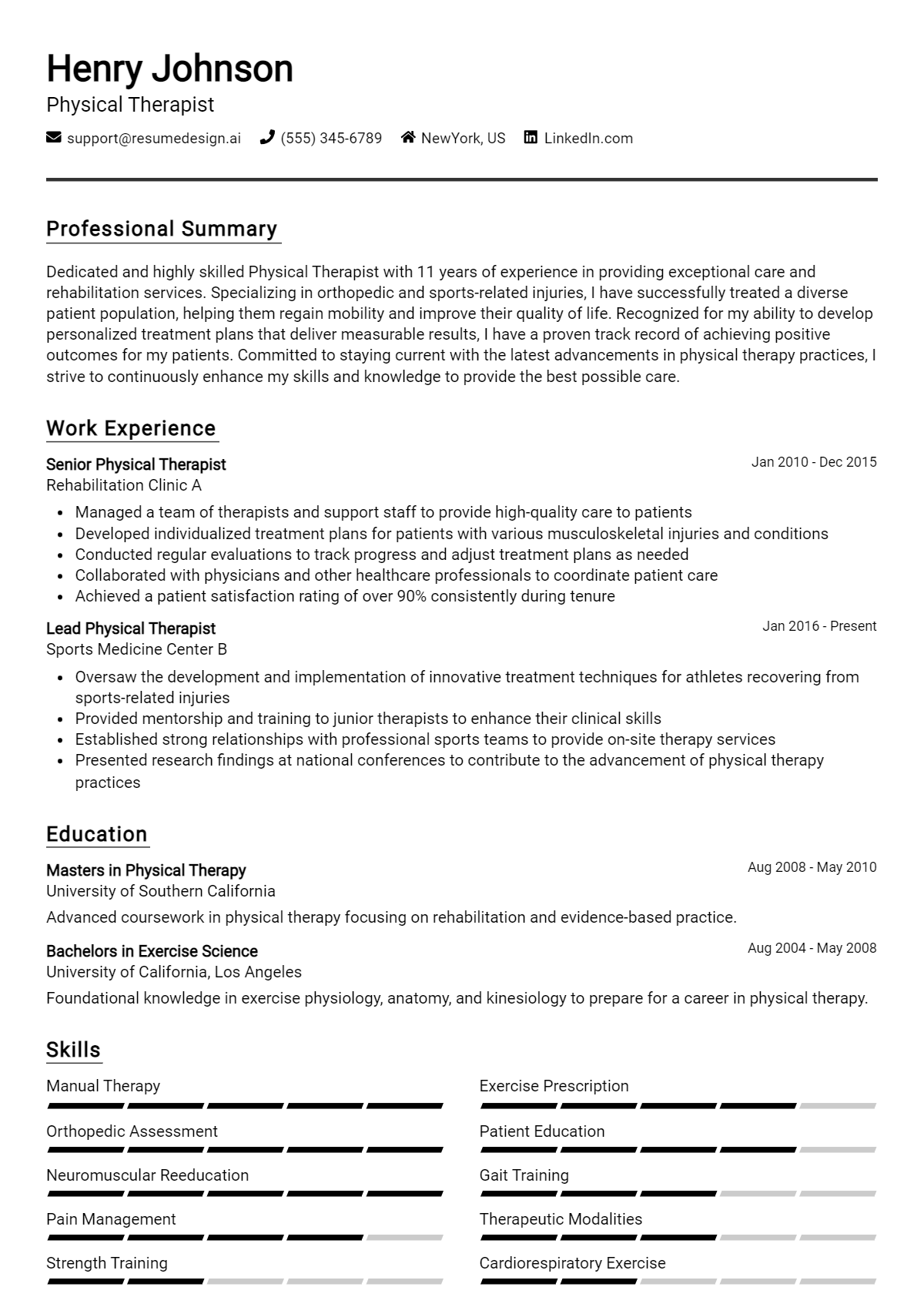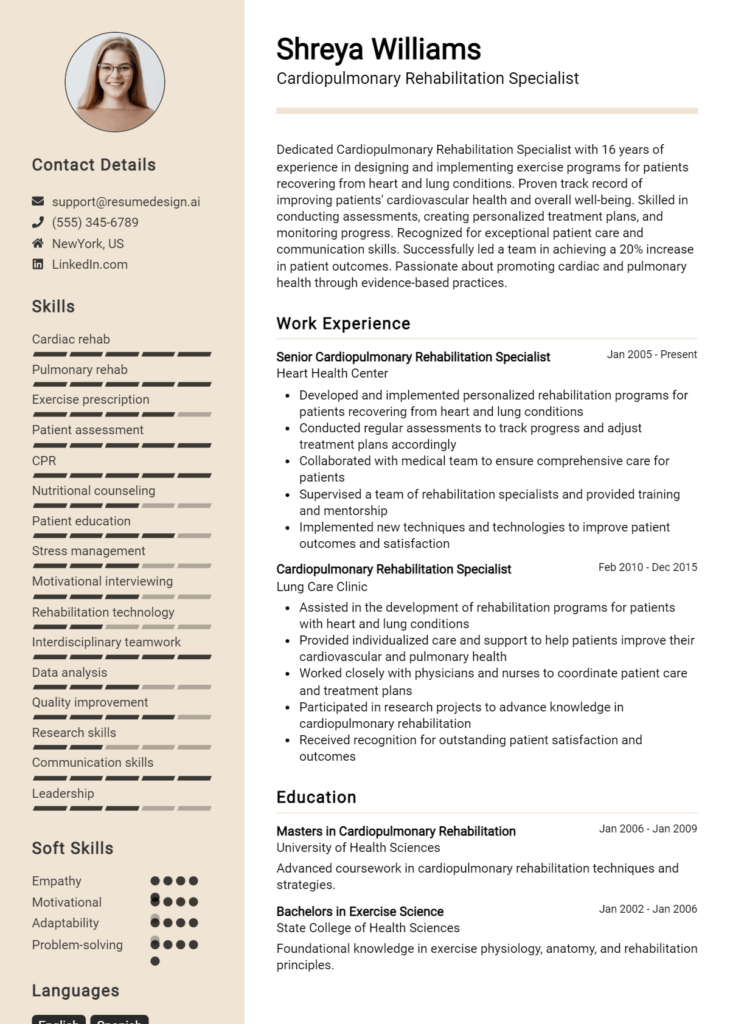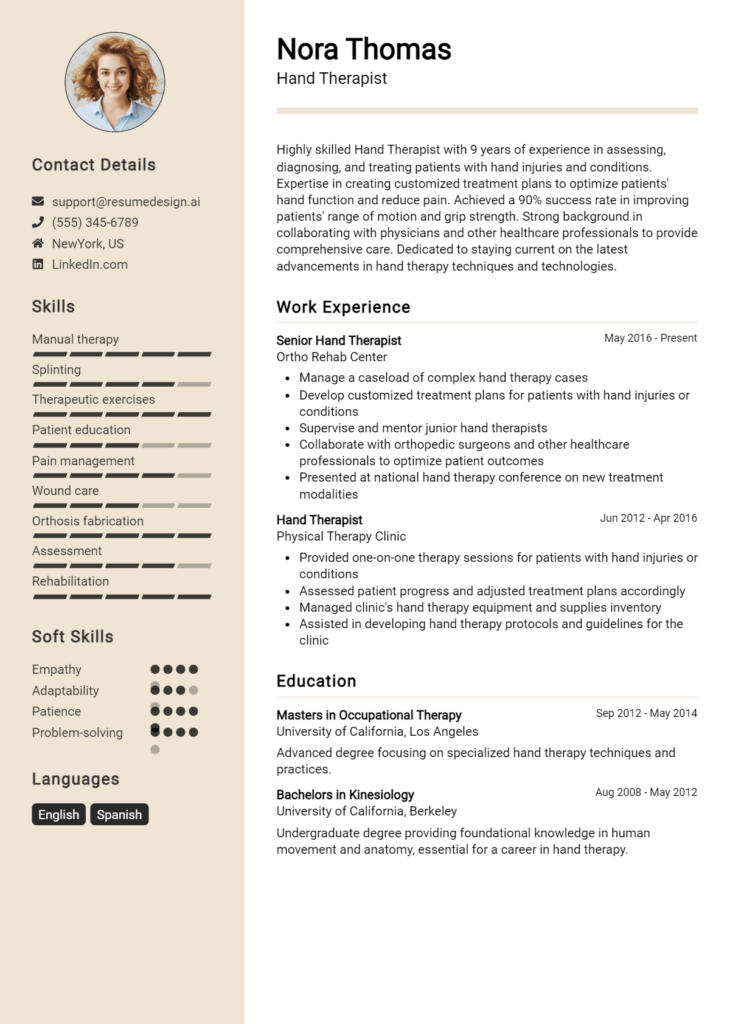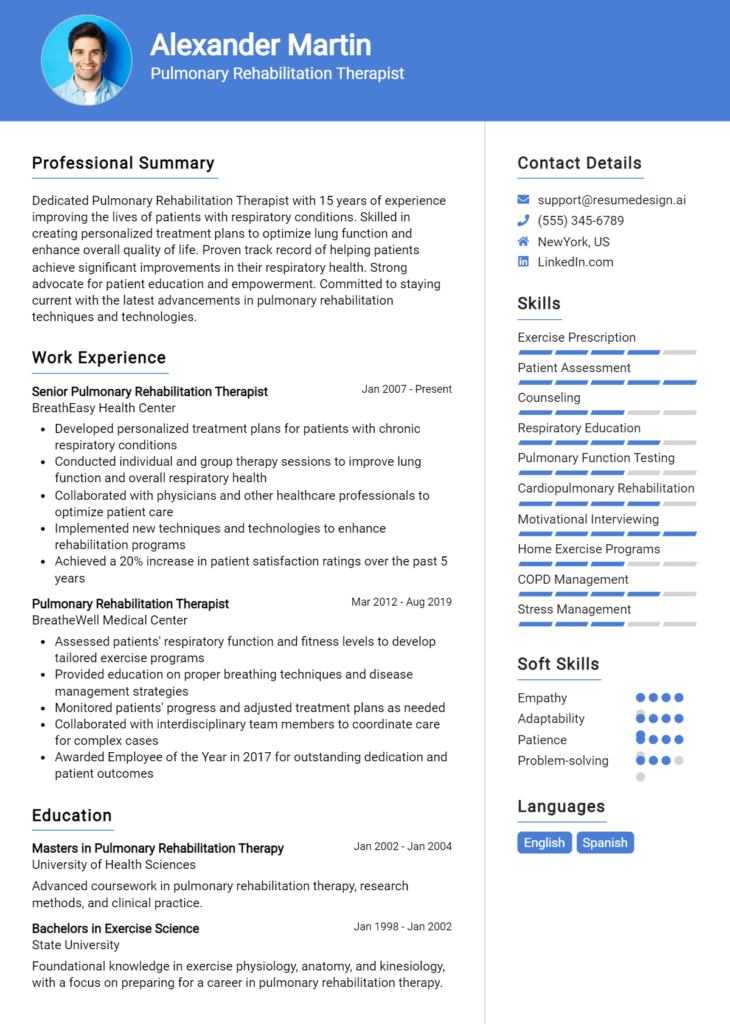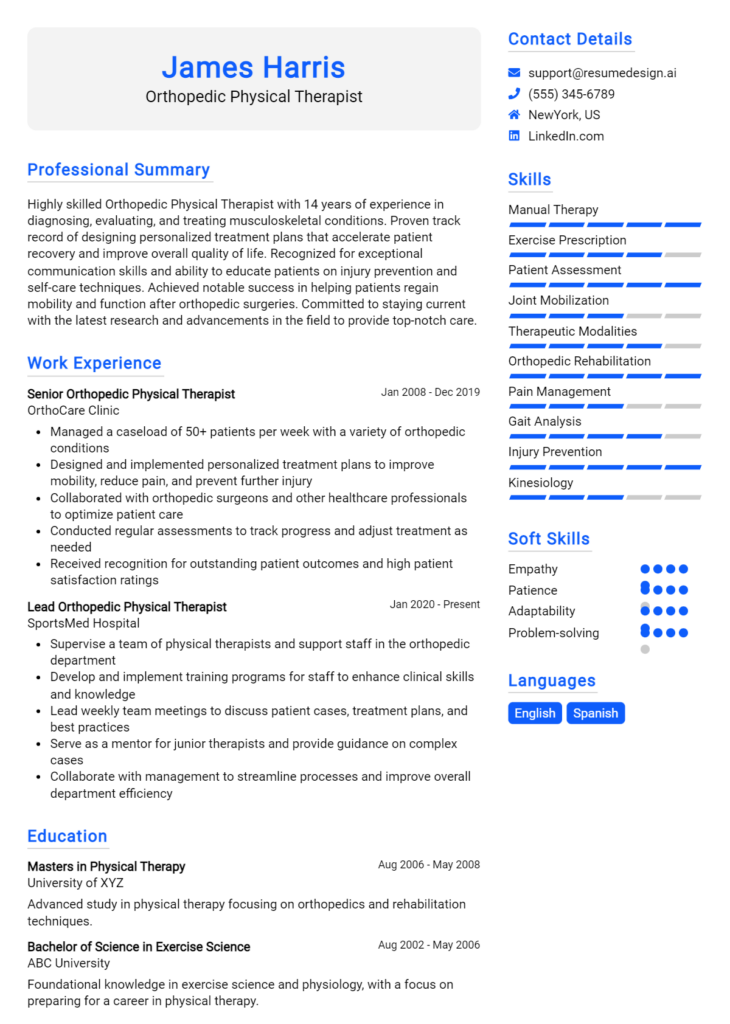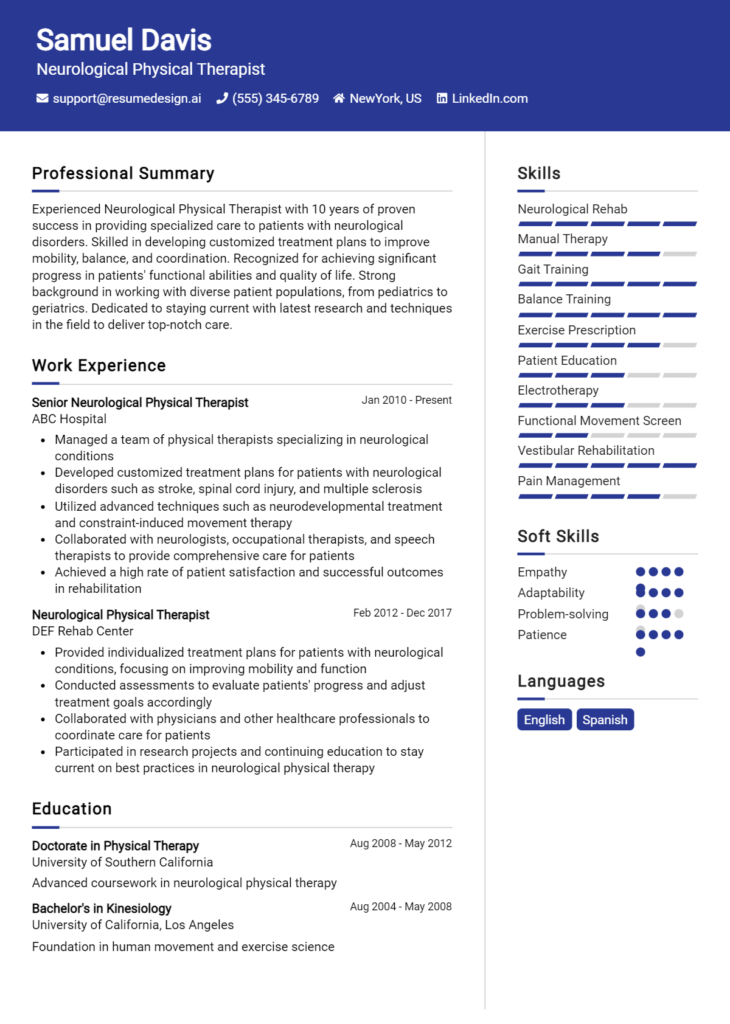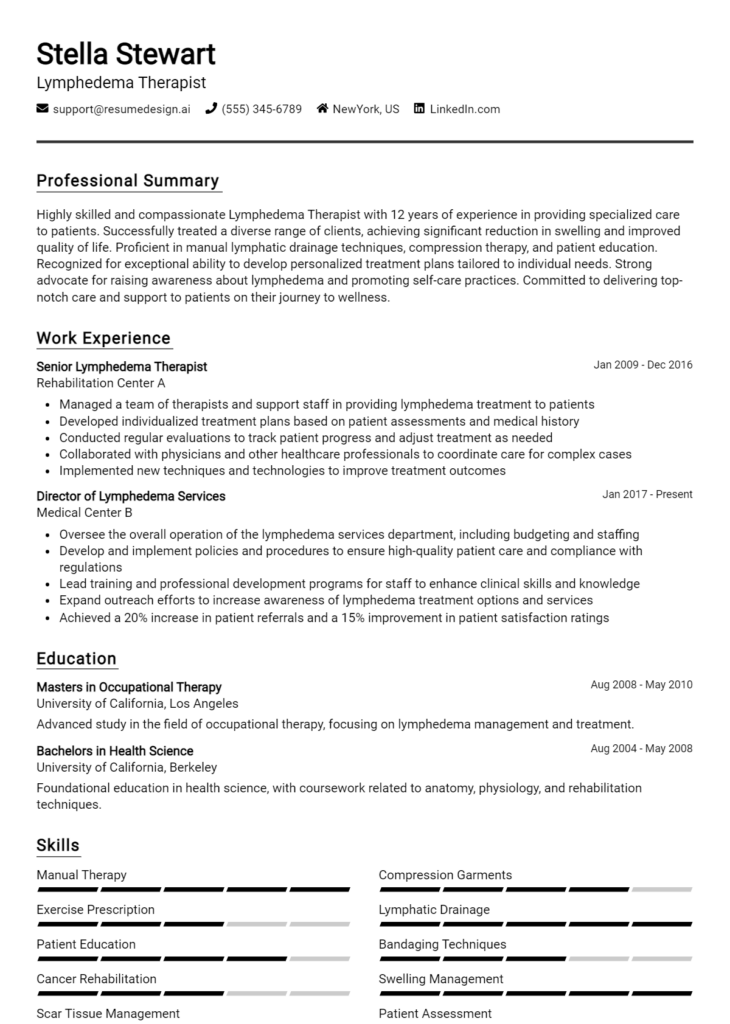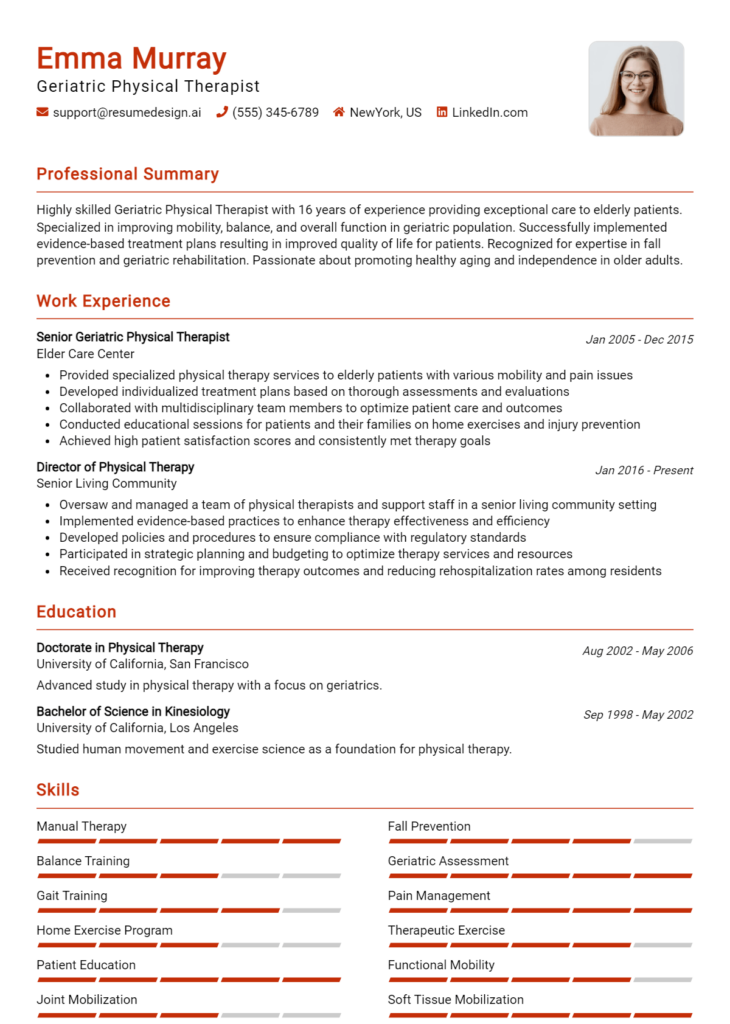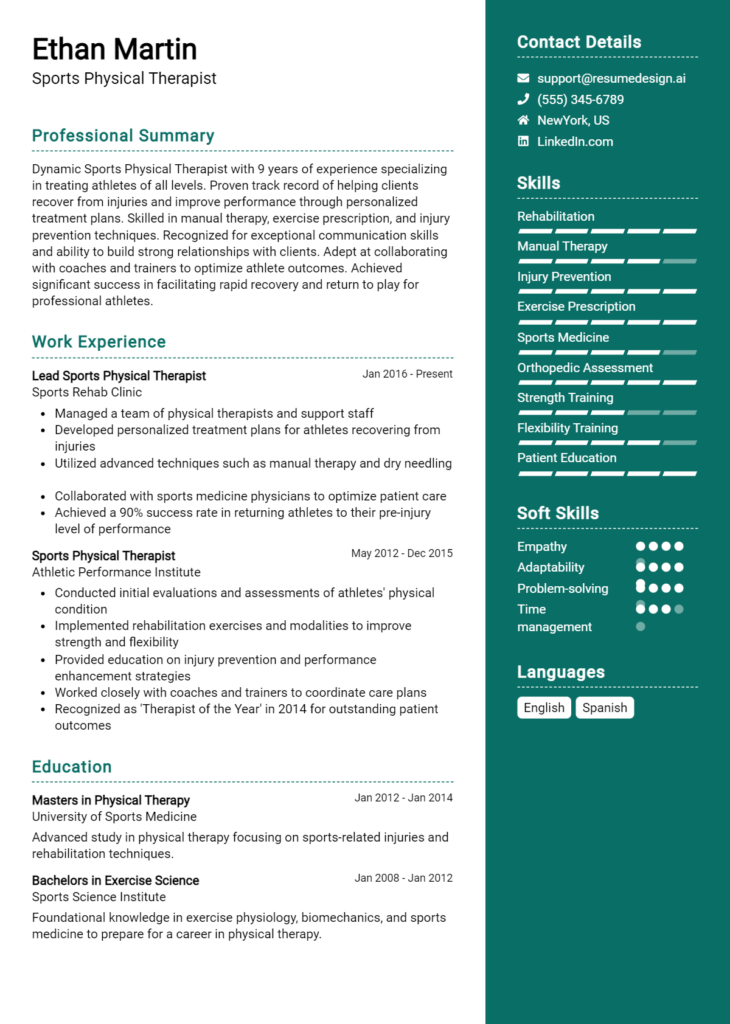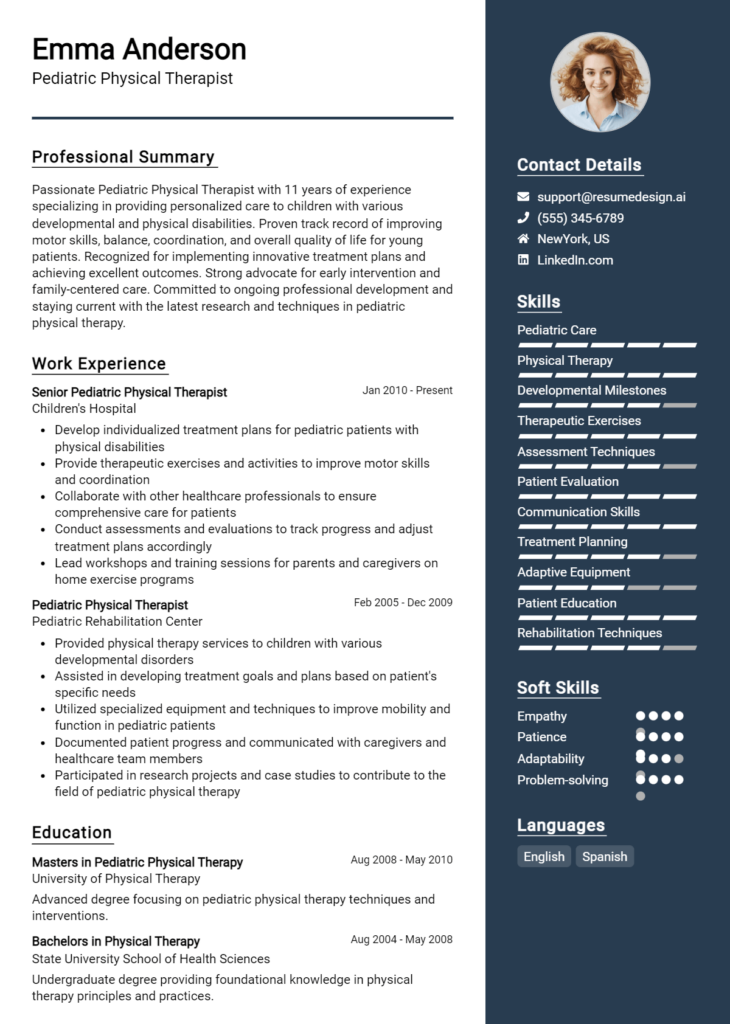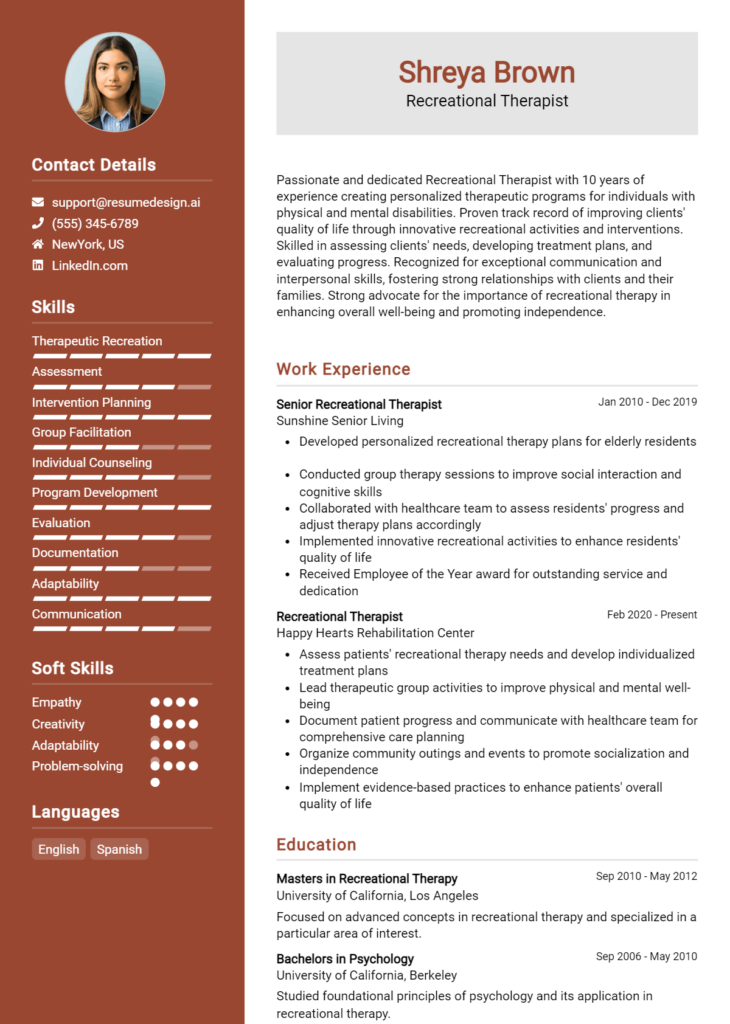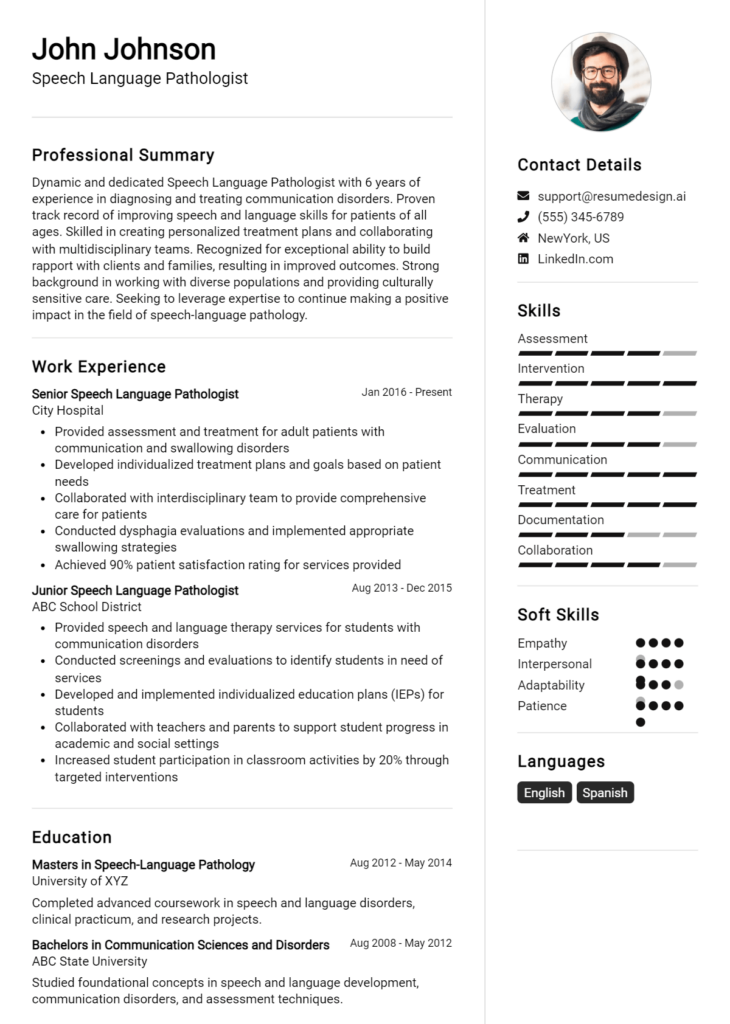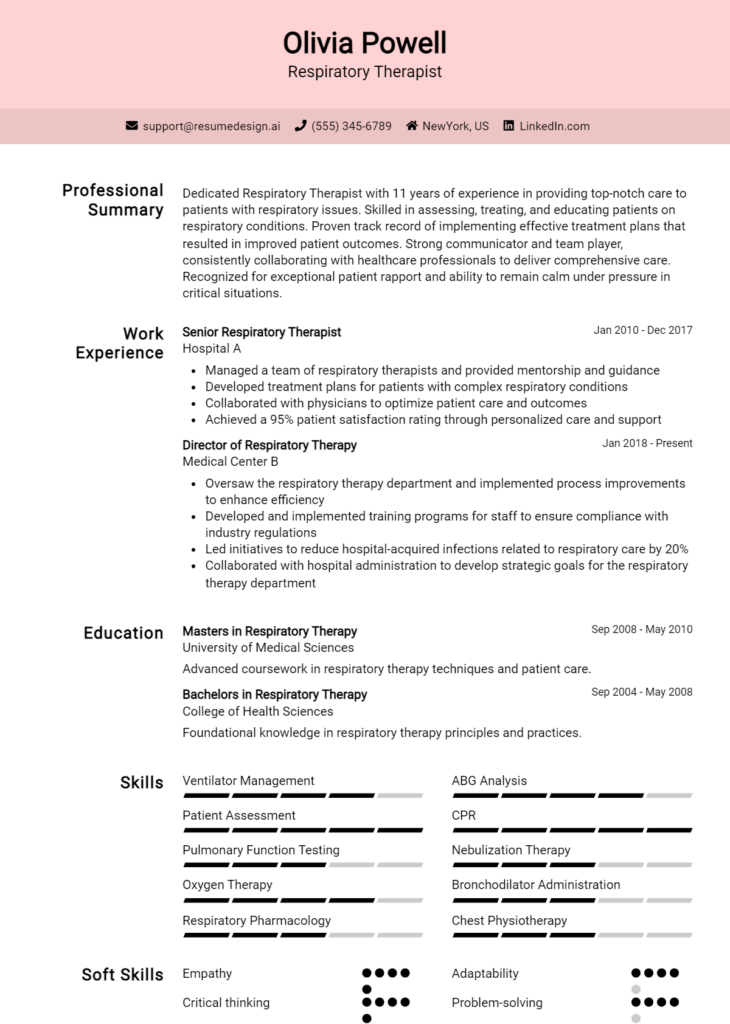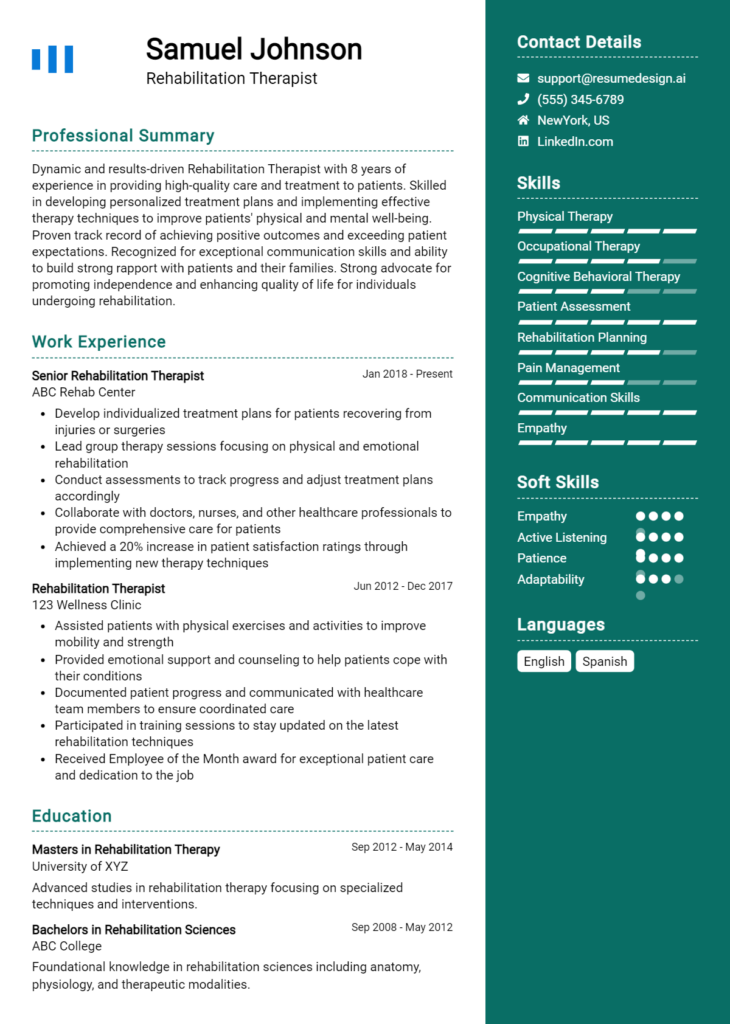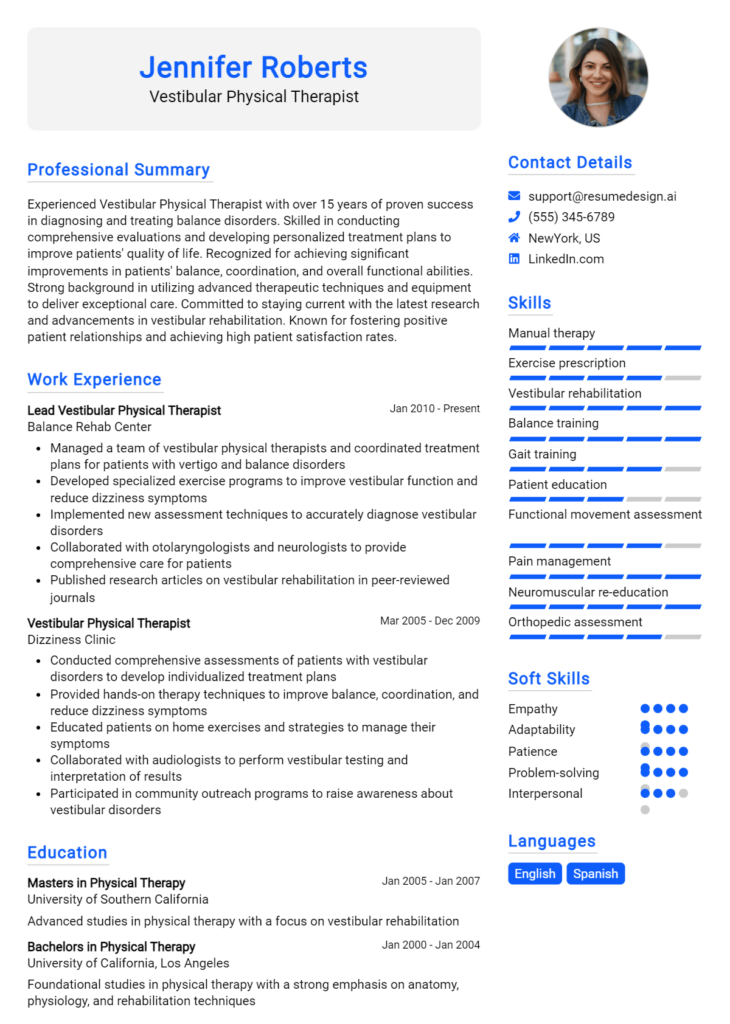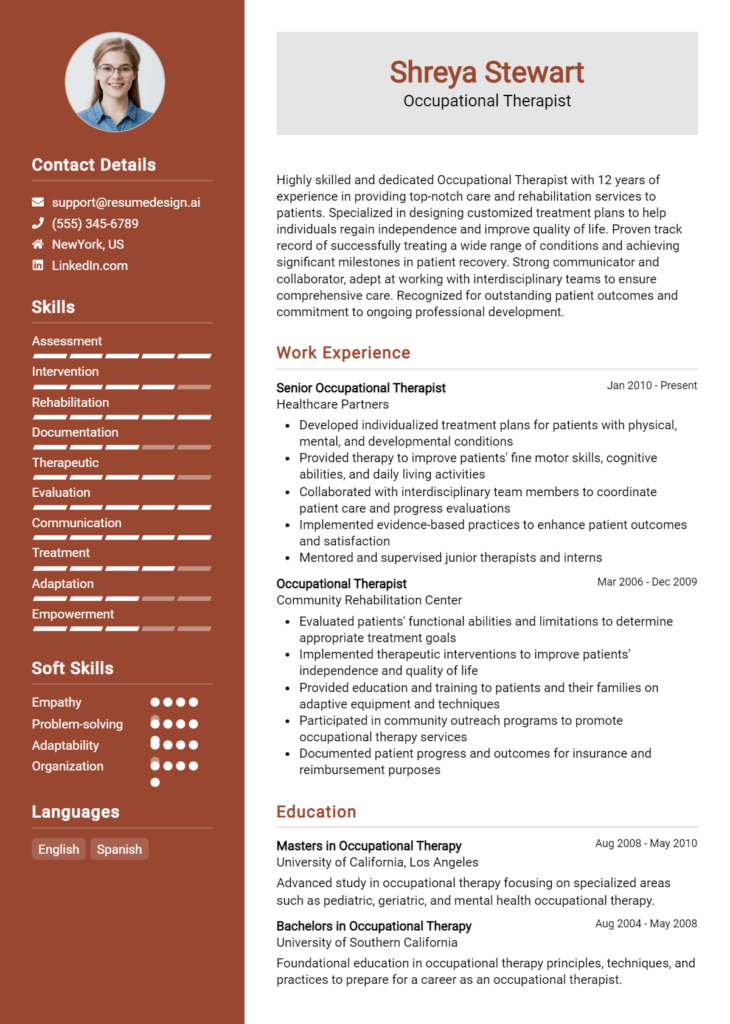Physical Therapist Core Responsibilities
Physical Therapists play a crucial role in patient recovery, focusing on assessing, planning, and implementing rehabilitation programs. Key responsibilities include evaluating patient conditions, developing personalized treatment plans, and collaborating with healthcare teams to ensure comprehensive care. Essential skills encompass technical proficiency in therapeutic techniques, operational knowledge of healthcare protocols, and strong problem-solving abilities to adapt treatments effectively. A well-structured resume highlighting these qualifications is vital for demonstrating how these competencies contribute to the organization’s overall goals.
Common Responsibilities Listed on Physical Therapist Resume
- Assessing patient physical abilities and limitations
- Developing individualized treatment plans
- Implementing therapeutic exercises and modalities
- Monitoring patient progress and modifying treatments
- Educating patients and families on rehabilitation processes
- Maintaining accurate patient records and documentation
- Collaborating with physicians and other healthcare professionals
- Staying updated with industry best practices and standards
- Providing guidance on injury prevention and wellness
- Utilizing specialized equipment for therapy sessions
- Conducting research to improve treatment methods
- Participating in community health programs and outreach
High-Level Resume Tips for Physical Therapist Professionals
A well-crafted resume is essential for Physical Therapist professionals as it serves as the first impression a candidate makes on a potential employer. In a competitive job market, your resume must effectively showcase not only your skills and qualifications but also your accomplishments in the field. It acts as your personal marketing tool, highlighting your expertise in patient care, rehabilitation techniques, and therapeutic practices. This guide will provide practical and actionable resume tips specifically tailored for Physical Therapist professionals, ensuring you present yourself in the best possible light to prospective employers.
Top Resume Tips for Physical Therapist Professionals
- Tailor your resume to the specific job description, emphasizing the skills and experiences that align with the employer's needs.
- Highlight relevant clinical experience, including internships and volunteer work, to demonstrate hands-on capabilities.
- Quantify your achievements whenever possible, such as the number of patients treated or improvements in patient outcomes.
- Showcase industry-specific skills, such as proficiency in therapeutic modalities, manual therapy techniques, and patient assessment tools.
- Include certifications and licenses prominently, as they are critical to establishing your credentials in the field.
- Utilize action verbs to describe your responsibilities and achievements, making your contributions compelling and impactful.
- Incorporate keywords from the job posting to optimize your resume for applicant tracking systems (ATS).
- Maintain a clean and professional format, ensuring readability and quick access to key information for hiring managers.
- Consider adding a summary statement that encapsulates your career goals and what you bring to the role of a Physical Therapist.
By implementing these tips, you can significantly enhance your resume and increase your chances of landing a job in the Physical Therapist field. A well-structured and tailored resume will not only attract the attention of hiring managers but also effectively communicate your unique value as a healthcare professional committed to improving patient care and outcomes.
Why Resume Headlines & Titles are Important for Physical Therapist
In the competitive field of physical therapy, a well-crafted resume headline or title plays a crucial role in capturing the attention of hiring managers. It serves as a brief summary of a candidate's key qualifications, allowing them to stand out in a sea of applications. A strong headline should be concise, relevant, and directly related to the position being applied for, effectively encapsulating the candidate's expertise and unique selling points. By presenting this information in a compelling phrase, physical therapists can make a lasting first impression that encourages hiring managers to explore their resumes further.
Best Practices for Crafting Resume Headlines for Physical Therapist
- Keep it concise: Aim for one impactful phrase that summarizes your qualifications.
- Make it role-specific: Tailor your headline to reflect the specific physical therapy position you are applying for.
- Highlight key strengths: Incorporate your most relevant skills and achievements into the headline.
- Use action-oriented language: Choose strong verbs or descriptors that convey your capabilities.
- Avoid jargon: Ensure that your headline is easily understood by a broad audience, including HR professionals.
- Incorporate certifications: Mention any relevant licenses or certifications that set you apart.
- Focus on results: If possible, hint at achievements or outcomes that demonstrate your effectiveness.
- Revise and refine: Don’t hesitate to revise your headline until it accurately reflects your professional identity.
Example Resume Headlines for Physical Therapist
Strong Resume Headlines
Dedicated Physical Therapist with 5+ Years of Experience in Rehabilitation and Pain Management
Results-Driven Physical Therapist Specializing in Sports Injury Recovery and Preventive Care
Licensed Physical Therapist Committed to Enhancing Patient Mobility and Quality of Life
Compassionate Physical Therapist with Proven Success in Outpatient Care and Patient Education
Weak Resume Headlines
Physical Therapist Seeking Job
Experienced Healthcare Professional
The strong resume headlines are effective because they are specific, highlight key qualifications, and convey a sense of purpose and expertise. They immediately communicate the candidate's strengths and relevance to the role, making it easier for hiring managers to assess fit. In contrast, the weak headlines fail to provide any meaningful information, relying on vague language that lacks impact. This generic approach not only makes it difficult for candidates to stand out but also leaves hiring managers unimpressed and uncertain about the candidate's unique qualifications.
Writing an Exceptional Physical Therapist Resume Summary
A resume summary is a critical component of a Physical Therapist's resume, serving as a first impression that can significantly influence hiring managers' perceptions. A well-crafted summary quickly captures attention by highlighting essential skills, relevant experience, and notable accomplishments tailored to the specific job at hand. By being concise and impactful, the summary not only conveys the candidate's qualifications but also their potential to contribute effectively to the organization, making it a vital tool in the job application process.
Best Practices for Writing a Physical Therapist Resume Summary
- Quantify Achievements: Use numbers to highlight the impact of your work, such as the percentage of patient recovery or the number of patients treated.
- Focus on Skills: Clearly mention key skills such as manual therapy, patient assessment, and rehabilitation techniques relevant to the role.
- Tailor to the Job Description: Customize your summary to align closely with the specific requirements and responsibilities outlined in the job posting.
- Keep it Concise: Aim for 2-4 sentences that succinctly summarize your professional identity and key qualifications.
- Highlight Relevant Experience: Mention specific clinical settings or populations you've worked with that relate to the position.
- Showcase Certifications: If applicable, include relevant certifications or specializations that enhance your qualifications.
- Use Action Words: Begin sentences with strong action verbs to convey confidence and proactivity.
- Reflect Professionalism: Ensure the summary maintains a professional tone and is free of jargon or overly casual language.
Example Physical Therapist Resume Summaries
Strong Resume Summaries
Dedicated Physical Therapist with over 5 years of experience in outpatient settings, successfully increasing patient mobility by 30% through personalized rehabilitation programs. Proven expertise in manual therapy and exercise prescription, complemented by a Doctorate in Physical Therapy.
Compassionate and results-driven Physical Therapist with a history of treating diverse patient populations. Achieved a 95% patient satisfaction rating and improved functional outcomes for over 150 patients in a high-volume clinic. Certified in Dry Needling and Sports Rehabilitation.
Licensed Physical Therapist specializing in pediatric care, with a track record of enhancing patients' quality of life through innovative therapy techniques. Successfully led a team that reduced patient recovery time by 25% through evidence-based practices and collaborative care.
Weak Resume Summaries
Experienced Physical Therapist looking for a new position. I have worked with many patients and have various skills.
Physical Therapist with some experience. I hope to help patients improve their health and mobility.
The strong resume summaries are effective because they incorporate quantifiable outcomes, specific skills, and relevant experiences that directly relate to the Physical Therapist role. They convey a clear sense of the candidate’s accomplishments and the value they can bring to the employer. In contrast, the weak summaries lack specificity and measurable results, making them too generic and less impactful, failing to capture the attention of hiring managers.
Work Experience Section for Physical Therapist Resume
The work experience section of a Physical Therapist resume is crucial as it provides a platform for candidates to showcase their technical skills, leadership capabilities, and commitment to delivering high-quality patient care. This section not only highlights relevant clinical experiences but also illustrates the candidate's ability to manage teams effectively and contribute positively to healthcare outcomes. By quantifying achievements—such as the number of patients treated or improvement in patient mobility—and aligning experiences with industry standards, candidates can demonstrate their value to potential employers, setting themselves apart in a competitive job market.
Best Practices for Physical Therapist Work Experience
- Utilize action verbs to start bullet points, emphasizing your proactive role.
- Quantify your achievements with specific metrics (e.g., percentage of patient recovery).
- Highlight technical skills relevant to the position, including modalities and therapeutic techniques.
- Showcase leadership experiences, such as supervising interns or managing patient care teams.
- Align your experiences with the job description to demonstrate relevance.
- Include continuing education or certifications that enhance your expertise.
- Describe collaborative efforts with other healthcare professionals to improve patient outcomes.
- Keep descriptions concise and focused on results to maintain clarity.
Example Work Experiences for Physical Therapist
Strong Experiences
- Successfully developed and implemented a rehabilitation program that improved patient mobility by 30% over six months.
- Led a team of 5 therapists in a hospital setting, achieving a 95% patient satisfaction rating for care quality.
- Conducted workshops on advanced therapeutic techniques, resulting in a 20% increase in staff proficiency and patient outcomes.
- Collaborated with orthopedic surgeons to create post-operative therapy plans, reducing recovery time by an average of 2 weeks for joint replacement patients.
Weak Experiences
- Assisted in physical therapy sessions with various patients.
- Worked with a team to provide general care and support.
- Participated in meetings to discuss patient progress.
- Engaged with patients during therapy sessions.
The examples categorized as strong experiences demonstrate clear, quantifiable outcomes and showcase specific skills and leadership roles, providing a compelling narrative of the candidate's impact in their previous positions. In contrast, the weak experiences lack specificity and measurable results, making them less effective in conveying the candidate's qualifications and contributions in the field of physical therapy.
Education and Certifications Section for Physical Therapist Resume
The education and certifications section of a Physical Therapist resume is crucial as it serves to highlight the candidate's academic background, industry-relevant certifications, and commitment to continuous learning. This section not only showcases the foundational knowledge acquired through formal education but also emphasizes specialized training and credentials that align with industry standards. By providing relevant coursework, certifications, and any additional training, candidates can significantly enhance their credibility and demonstrate their preparedness for the responsibilities of a Physical Therapist role.
Best Practices for Physical Therapist Education and Certifications
- List your highest degree first, including the name of the institution and graduation date.
- Include relevant certifications, such as the National Physical Therapy Examination (NPTE) and any state licenses.
- Add specialized training that relates to specific areas of physical therapy, such as orthopedic or neurological rehabilitation.
- Highlight any continuing education courses that showcase your commitment to staying current in the field.
- Use bullet points for clarity and to make it easy for hiring managers to skim your qualifications.
- Tailor your education and certifications section to match the job description, focusing on the most relevant qualifications.
- Include any honors or awards received during your education to further establish credibility.
- Keep the section organized and concise, ensuring that it flows well with the rest of your resume.
Example Education and Certifications for Physical Therapist
Strong Examples
- Doctor of Physical Therapy (DPT), University of Health Sciences, Graduated May 2020
- Licensed Physical Therapist, State of California, License #12345678
- Certified Orthopedic Specialist (OCS), American Board of Physical Therapy Specialties, 2021
- Continuing Education: Therapeutic Exercise and Rehabilitation Techniques, 2022
Weak Examples
- Bachelor of Arts in Psychology, University of Arts, 2015
- CPR Certification from Local Community Center, 2018 (not specific to healthcare)
- Basic First Aid Course, 2019 (not advanced or relevant to physical therapy)
- Certificate in Yoga Instruction, 2016 (not directly related to physical therapy practice)
The strong examples listed demonstrate relevant qualifications that directly align with the requirements of a Physical Therapist, showcasing advanced degrees and certifications that are recognized in the industry. In contrast, the weak examples reflect outdated or irrelevant qualifications that do not contribute to the candidate's credibility in the field of physical therapy. Including strong examples enhances the resume's impact, while weak examples can detract from the overall professionalism and relevance of the candidate's profile.
Top Skills & Keywords for Physical Therapist Resume
As a Physical Therapist, possessing the right skills is crucial for delivering effective patient care and achieving optimal rehabilitation outcomes. A well-crafted resume that highlights both hard and soft skills can significantly enhance a candidate’s appeal to potential employers. These skills not only reflect a therapist's technical expertise but also showcase their ability to communicate, empathize, and connect with patients on a personal level. By emphasizing these skills, therapists can demonstrate their readiness to tackle the challenges of the job and provide high-quality care to diverse patient populations.
Top Hard & Soft Skills for Physical Therapist
Soft Skills
- Excellent communication skills
- Empathy and compassion
- Active listening
- Problem-solving abilities
- Adaptability and flexibility
- Team collaboration
- Time management
- Patience
- Attention to detail
- Critical thinking
Hard Skills
- Knowledge of anatomy and physiology
- Proficiency in therapeutic techniques
- Experience with rehabilitation equipment
- Patient assessment and evaluation
- Treatment planning
- Manual therapy skills
- Knowledge of medical terminology
- Familiarity with electronic health records (EHR)
- CPR and First Aid certification
- Understanding of health and safety regulations
For more insights on the essential skills to include in your resume, check out this resource on skills. To effectively showcase your background, don’t forget to highlight your relevant work experience as well.
Stand Out with a Winning Physical Therapist Cover Letter
Dear [Hiring Manager's Name],
I am writing to express my interest in the Physical Therapist position at [Company Name], as advertised on [where you found the job listing]. With a Doctorate in Physical Therapy and over [X years] of hands-on experience in diverse clinical settings, I am confident in my ability to provide high-quality care and contribute positively to your team. My dedication to enhancing patient mobility and improving overall quality of life aligns perfectly with your mission to deliver compassionate and effective rehabilitation services.
In my previous role at [Previous Employer], I successfully developed and implemented personalized treatment plans for patients recovering from various orthopedic and neurological conditions. I collaborated closely with multidisciplinary teams to ensure comprehensive care, which resulted in a [specific achievement or statistic, e.g., "30% increase in patient satisfaction scores"]. My strong communication skills and empathetic approach allowed me to build trusting relationships with patients, empowering them to take an active role in their recovery journey. I am particularly drawn to [Company Name] because of your commitment to innovative therapy techniques and patient-centered care, which I believe is paramount in achieving optimal outcomes.
I am eager to bring my expertise in manual therapy, therapeutic exercises, and patient education to [Company Name]. I am also enthusiastic about continuing my professional development through the opportunities available within your organization. I am excited about the possibility of contributing to your team and helping your patients achieve their rehabilitation goals. Thank you for considering my application. I look forward to the opportunity to discuss how my skills and experiences align with the needs of your team.
Sincerely,
[Your Name]
[Your Phone Number]
[Your Email Address]
Common Mistakes to Avoid in a Physical Therapist Resume
When crafting a resume for a physical therapist position, it's essential to present your qualifications and experiences in the best possible light. However, many applicants make common mistakes that can undermine their chances of landing an interview. By avoiding these pitfalls, you can create a compelling resume that effectively showcases your skills and expertise in the field. Here are some common mistakes to steer clear of:
Using a Generic Template: Relying on a one-size-fits-all resume template can make your application feel impersonal and may not highlight the unique skills pertinent to physical therapy.
Neglecting Specific Skills: Failing to include specialized skills, such as knowledge of therapeutic techniques or familiarity with rehabilitation equipment, can lead to a lack of interest from employers looking for specific competencies.
Overloading with Jargon: While it’s important to demonstrate your expertise, using excessive medical jargon can alienate hiring managers who may prefer clear and concise language.
Ignoring Certifications and Licenses: Not prominently displaying relevant certifications (like a state license or specialty credentials) can lead to your resume being overlooked, as these qualifications are critical in the healthcare field.
Listing Duties Instead of Achievements: Simply stating job responsibilities instead of highlighting quantifiable accomplishments can make your experience seem less impactful. Focus on what you achieved in your previous roles.
Omitting Continuing Education: Physical therapy is a field that requires ongoing education; failing to mention any additional training or workshops can make your resume seem outdated.
Poor Formatting and Structure: A cluttered or confusing layout can distract from the content of your resume. Use clear headings, bullet points, and a clean design to ensure readability.
Neglecting a Tailored Objective Statement: A generic objective statement can weaken your resume. Instead, tailor your objective to align with the specific job you are applying for, demonstrating your enthusiasm and fit for the role.
Conclusion
As we explored the vital role of physical therapists in promoting rehabilitation and enhancing patients' quality of life, it became clear that a well-crafted resume is essential for standing out in this competitive field. We discussed the importance of highlighting relevant skills, clinical experience, and educational background, as well as tailoring your resume to specific job descriptions.
In addition, we emphasized the significance of including certifications and continuing education, which can set you apart from other candidates. Networking and professional development are also key components to consider when pursuing a career in physical therapy.
Now that you have a comprehensive understanding of what makes a strong physical therapist resume, it's time to take action. Review your own resume and ensure it reflects your unique qualifications and experiences effectively. To assist you in this process, check out the variety of resources available:
- Explore resume templates to find a design that suits your professional style.
- Use the resume builder to create a polished and professional document with ease.
- Look at resume examples for inspiration and guidance on formatting and content.
- Don't forget to draft a compelling cover letter with the help of cover letter templates that can further showcase your skills and enthusiasm for the role.
Take the next step in advancing your physical therapy career by enhancing your resume today!

